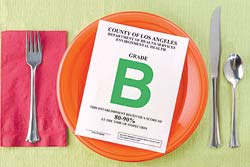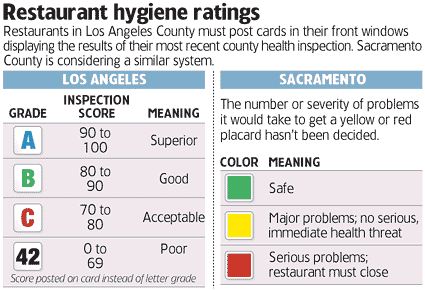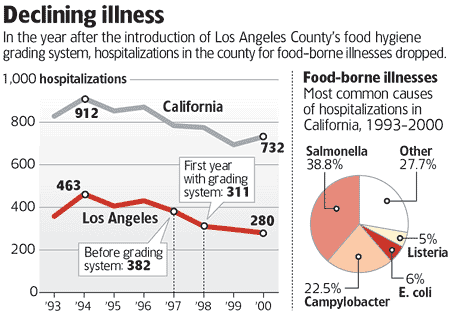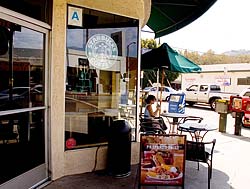Keeping score on cleanlinessReports of unsanitary conditions spurred a new disclosure law for restaurants in Los Angeles County. Diners depend on the letter grades, and now Sacramento County is considering a similar system. |

Sacramento Bee photo
illustration/Scott Lorenzo and Nathaniel Levine
|
LOS ANGELES - On one of those sunny Southern California
days, coffee-drinking noshers clustered outside a
Starbucks, not far from a big, bold letter "A" posted
next to the front door.
This Starbucks, on trendy Ventura Boulevard in Studio City, proffers not only its ubiquitous liquid menu, but a government-imposed rating that conveys how the restaurant fared on a recent health inspection. Ian Jensen, who shared a patio table with other latte-sippers, said Los Angeles County's practice of prominently posting letter grades at restaurants is a welcome mainstay of the local dining scene. |
|
"If I go to a new restaurant, I always look to see what
the letter is," the 28-year-old said.
Sacramento County is considering a similar plan to post a flashcard-type health department rating in restaurants. County environmental health officials are expected to present the proposal to the Board of Supervisors in November. According to the California Restaurant Association, several California cities and counties are calling for more public disclosure of health department ratings. Restaurants in Riverside, San Bernardino and San Diego counties already use letter grades, said Kearsten Shepherd, a spokeswoman for the Sacramento-based association. Napa, Lake and Solano counties in Northern California are considering such postings. The association generally opposes a grading system because of the potential for inconsistencies, Shepherd said. An "A" in one county could mean something different in another. "It's just a nightmare for restaurant owners," she said. Los Angeles County supervisors thought otherwise after a local television news investigation unearthed stomach-churning restaurant conditions. The supervisors implemented reforms in 1998 that included the letter-grade system. Diners rely on it, restaurant managers heed it, and public health officials applaud it. A study of California hospital statistics showed an adjusted 13 percent decline in food-borne illnesses such as salmonella among Los Angeles County patients in the year after the grading system began, said Dr. Jonathan E. Fielding, Los Angeles County's director of public health. A recent study showed the decrease continued for the next two years, Fielding said. Those are the kinds of results helping drive public demand in Sacramento County, said Mel Knight, director of Sacramento County's Environmental Management Department. The county inspects restaurants twice a year. Eating establishments must post their most recent inspection report, but the multi-page documents are technical and difficult to peruse. Knight is proposing that retail food establishments in Sacramento County be required to post a red, yellow or green placard in a window, ranking how they fared on their last inspection. A restaurant with serious sanitation problems would be closed and forced to post a red placard. Restaurants with problems considered major but not an immediate, serious health threat could stay open but would be required to post a yellow placard. Safe restaurants would post a green placard. Yellow or red placards would be removed once a problem is fixed. "It's simple," Knight said. "Everyone is conditioned to know what red-yellow-green is." All restaurants in unincorporated Los Angeles County and most of its 85 cities participate in the letter-grade system. As of August, 32,826 eating establishments, or 87.9 percent, had A grades; 4,203 eateries, or 11.3 percent, had B grades; and 305, or 0.8 percent, posted C ratings. Before ratings were posted, at least 10 percent of the restaurants typically would fall into the C category, Fielding said. The change points to a more vigilant restaurant industry, he said. Comparing tax receipts, the county found that revenue at restaurants declined with falling grades, Fielding said. Los Angeles County bestows certificates upon restaurants that consistently score 100 percent, the highest A rating. Winners range from tiny walk-up counters and familiar chains to high-end celebrity magnets like Ivy at the Shore in Santa Monica. Lily's Cafe & Pastries on Pacific Coast Highway in Malibu has served up an eclectic menu of burritos and doughnuts with an A grade since the rating system began. Feeding 400 people from his 900-square-foot place every day and maintaining a spotless record takes diligence and money, said owner Abel Castro. "You just do what the health inspectors tell you to; don't argue with them," he said. "If something has to be replaced, replace it. If this has to be changed, change it." Improper food temperature is the major cause of food illness, according to the Centers for Disease Control and Prevention - a truism Castro honors. He once replaced a faulty refrigerator after several repairs because the temperature fluctuated. "Temperature is key," he said. Rather than neglect, Castro is convinced a lot of restaurants don't have the budget to keep up with repairs or replacements. "I always feel sorry for those who don't have an A," he said. Los Angeles County routinely inspects eateries three times a year. Restaurants displeased with their score can pay for one reinspection a year and can appeal to an ombudsman. Jensen, at the Starbucks in Studio City, is an actor and a waiter. He's seen the rating system's influence from the inside. "All restaurants take it seriously," he said. |

Sources: Los Angeles and Sacramento counties
Sacramento Bee

Source: Journal of Environmental Health
Sacramento Bee/Nathaniel Levine

The Los Angeles County Health Department's "A" rating is prominently
displayed
at the Starbucks on Ventura Boulevard in Studio City.
Sacramento Bee/Brian Baer

|
Mel
Knight, director of Sacramento County's Environmental
Management Department, was impressed by reports of
declining rates of food-borne illness after after the
system was implemented in Los Angeles County and is
leading the drive to start a similar program here. Safe
restaurants would post a green placard; yellow or red
placards would removed once a problem is fixed. "It's
simple," Knight said. "Everyone is conditioned to know
what red-yellow-green is." Napa, Solano and Lake
counties are also considering similar rating systems.
|